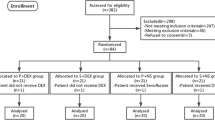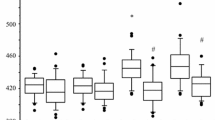Abstract
Purpose. The effects of sevoflurane and propofol, in combination with continuous epidural blockade, on blood pressure control and time of recovery from anesthesia were compared.
Methods. Adult patients were allocated to either a sevoflurane (n=54) or a propofol (n=64) group. Anesthesia was induced with either inhalation of 5% sevoflurane or intravenous administration of 2 mg·kg−1 propofol. After an injection of vecuronium, the trachea was intubated and anesthesia was maintained with continuous epidural blockade, air/oxygen, and sevoflurane or propofol. The systolic arterial pressure was maintained within ±30% of that obtained on the ward.
Results. The number of cases requiring a change in the dose of either anesthetics or vasoactive agents was not different between the groups. However, the arterial pressure and heart rate were more stable in the propofol group than in the sevoflurane group (P<0.05). The length of time before tracheal extubation was shorter in the sevoflurane group (10.4±5.2 min, mean±SD) than the propofol group (15.0±11.2 min,P<0.05).
Conclusion. Propofol anesthesia, in combination with continuous epidural blockade, results in more stable intraoperative hemodynamics than sevoflurane anesthesia, but requries a longer recovery time and results in larger interindividual variability than sevoflurane anesthesia.
Similar content being viewed by others
References
Segawa H, Mori K, Kasai K, Fukata J, Nakao K (1996) The role of the phrenic nerves in stress response in upper abdominal surgery. Anesth Analg 82:1215–1224
Smith I, Ding Y, White PF (1991) Comparison of sevoflurane-N2O and propofol-isoflurane-N2O. Anesthesiology 75:A344
Yamada K, Shingu K, Kimura H, Ikeda S, Tsushima K, Imanishi T, Murao K (1997) Circulatory and catecholamine responses to tracheal intubation and skin incision during sevoflurane, isoflurane, or halothane anesthesia. J Anesth 11:111–116
Shingu K, Osawa M, Mori K (1993) Modification of the stress responses with anesthesia during gynecological surgery: comparisons of propofol, sevoflurane and halothane anesthesia (in Japanese). Anesth Resus 29:69–76
Fredman B, Michael HN, Smith I, Wang J, Klein K, White PF (1995) Sevoflurane for outpatient anesthesia: a comparison with propofol. Anesth Analg 81:823–828
Jellish WS, Lien CA, Fontenot HJ, Hall R (1996) The comparative effects of sevoflurane versus propofol in the induction and maintenance of anesthesia in adult patients. Anesth Analg 82:479–485
Wandel C, Neff S, Bohrer H, Browne A, Motosch J, Martin E (1995) Recovery characteristics following anaesthesia with sevoflurane or propofol in adults undergoing out-patient surgery. Eur J Clin Pharmacol 48:185–188
Grounds RM, Maxwell DL, Taylor MB, Aber V, Royston D (1987) Acute ventilatory changes during iv induction of anaesthesia with thiopentone or propofol in man. Br J Anaesth 59:1098–1102
Hughes MA, Glass PSA, Jacobs JR (1992) Context-sensitive halftime in multicompartment pharmacokinetic models for intravenous anesthetic drugs. Anesthesiology 76:334–341
Author information
Authors and Affiliations
About this article
Cite this article
Tsushima, K., Shingu, K., Okuda, H. et al. A comparison between sevoflurane and propofol when combined with continuous epidural blockade in adult patients. J Anesth 12, 57–61 (1998). https://doi.org/10.1007/BF02480773
Received:
Accepted:
Issue Date:
DOI: https://doi.org/10.1007/BF02480773




